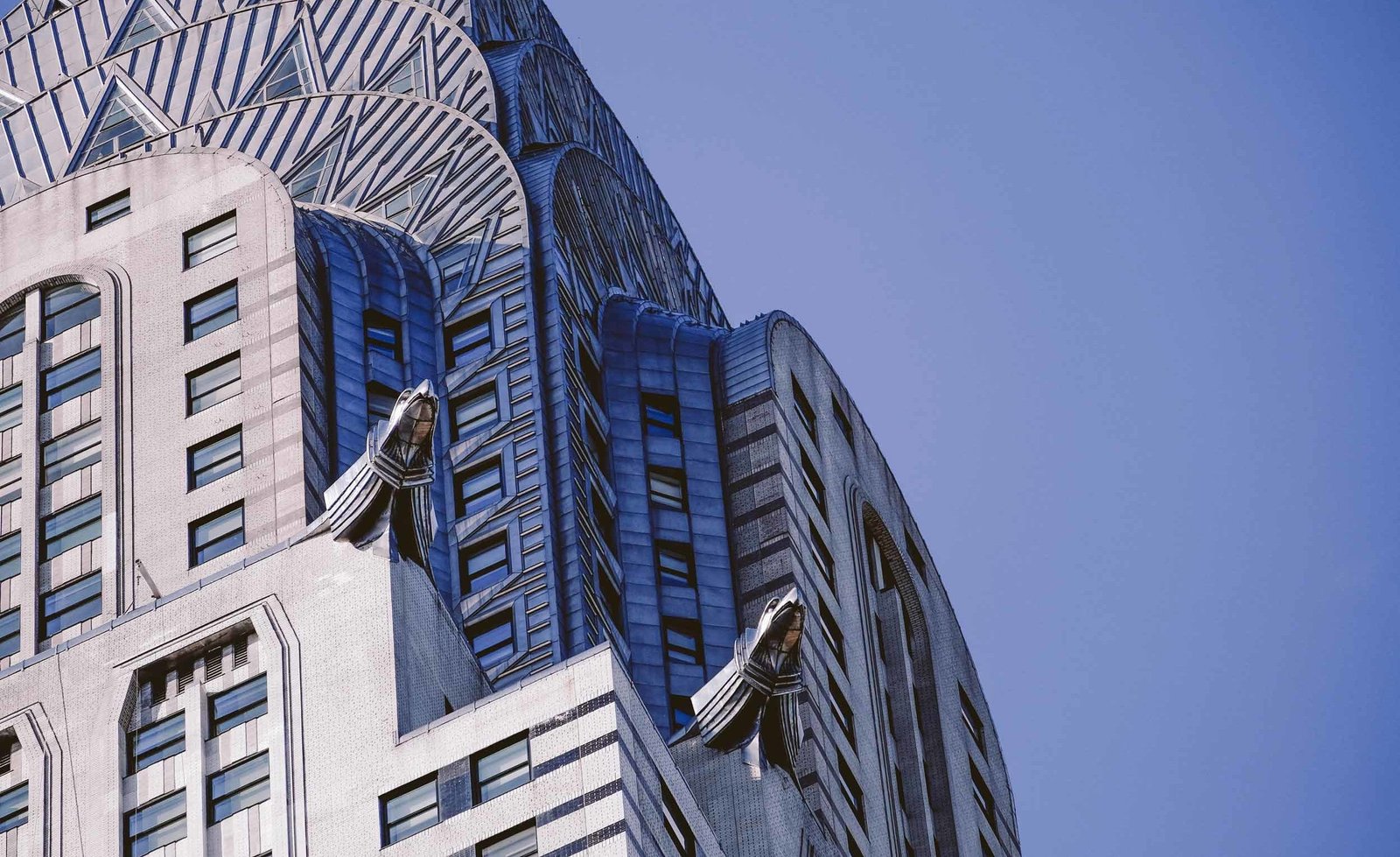A well-known lecturer, cultural historian and author of Art Deco New York, David Garrard Lowe explains what according to him is Art Deco.
One of the supreme visual delights of walking around New York today is the vibrant presence of the Art Deco skyscrapers: the Empire State building, with its dirigible mooring mast; the soaring Number One Wall Street, whose limestone walls shoot up like lithic fireworks; and the Waldorf- Astoria, whose twin towers received their inspiration from Inca temples. Delight is the operable word here. For Art Deco does delight. It is, at heart, a life-enhancing, urbanity. Art Deco, like Paris, the city it sprang from, cheers one. It is, indeed not unlike a chilled coupe of Champagne sipped in a Parisian café.
The structure that epitomizes most perfectly, to me, what Art Deco means is the Chrysler building. William Van Alen’s slender skyscraper has all of the accouterments of the Art Deco era.
The building embodies the style’s fascination with speed and movement, two signatures of the modern era. It is no accident that it is a tangible advertisement for the man who paid for it, Walter Chrysler. It is significant that the 31st floor setback is embellished with facsimiles of hood ornaments and radiator caps of the 1929 Chrysler. These Moderne gargoyles drive away all memories of the past transportation- horses and buggies and chariots. The décor and the upper level suggests the spokes of automobile tires. Now, better lit than ever before, they appear to whirl in the night sky. The Nirosta steel needle pierces the clouds.
One of the glories of Art Deco is its enthusiastic embrace of beauty. This is, no doubt, due to its birthplace- France. To stand in front of one of Paris’s earliest Art Deco masterpieces, Auguste Perret’s 1913 Théâtre des Champs- Elysées illustrates this perfectly. The severely geometric structure is enlivened with appropriately modern dancers by the splendid sculptor Antoine Bourdelle.
The Chrysler Building’s lobby is a dazzling exemplification of the style’s unabashed romance with beauty. One enters through a colossal portal set in gleaming black granite, held aside like a parting stage curtain. In the lobby, the ceiling is a wonderful canopy with, at its center, a perspective view of the building itself. The doors of its elevators not only exemplify the style’s obsession with beauty, but also its quest to search the world for new inspiration. Here is the recent discovery of the tomb of Tutankhamen; the doors bear the image of the fans painted on a sumptuous box found in his tomb in 1922. Even the little stairway at the corner of the lobby, which leads to the second floors, exemplifies in the swirl of its metallic railing the charm of Art Deco design.
The incorporation of the image of speed into Art Deco design is a natural consequence of the proliferation of new modes of transportation– dirigibles, airplanes, sleek ocean liners, and high- speed trains. On the broad Hudson River, across town from the Chrysler Building, in the 1930s, rode the greatest ocean liner ever built. The SS Normandie faluntred to the world the glories of French style. Here in this thousand-foot long ship was a treasure chest of the supreme designers of the time. Here were rooms and furnishings by the likes of Émile-Jacques Ruhlmann, Jules Leleu, Jean Dupas, Jean Dunand, Louis Suë et André Mar, and Christofle, creating the perfect mise en scéne for ladies dressed by Coco Chanel, Elsa Schiaparelli, and Madeline Vionnet.
And within the Beaux Arts glories of grand Central terminal, just across Lexington Avenue from the Chrysler Building, was found the ne plus ultra of Art Deco transportation at its birth, the 1938 20th Century Limited. Every afternoon this masterpiece designed by Henry Dreyfus rolled out of the terminal, its striking neon-lit dining room filled with exquisitely dressed passengers quaffing that most eco of cocktails, that alluring mixture of gin and vermouth, the martini, while outside the American landscape unfolded in a living panorama. The very words, “We are going to Chicago and on the coast,” carried the glamour of the time.
How blessed Gotham is to have these steel and glass exemplars of the dazzling Art Deco decades. Entering their breathtaking lobbies, especially the Chrysler Building’s, one can almost hear FDR’s distinctive voice, see Ruby Keeler tapping her way along 42nd Street, or note the resonant whistle of the RMS Queen Mary as tugs guide her out to sea.
This article has been reproduced from the Journal of The Art Deco Society of New York. It originally appeared in the Winter 2018 issue of the journal.

